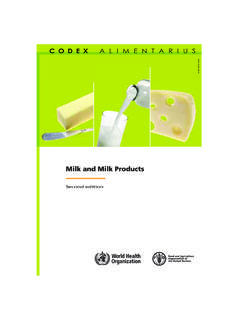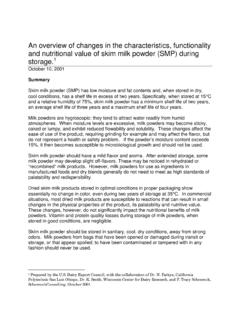Transcription of Acidified Milk Products and Protein Stabilisation
1 Acidified milk Productsand Protein StabilisationPectins for Acidified milk products23 ContentPECTIN IN milk Products 4 milk Products : healthy and convenient4 Pectin in milk products5 BASIC INFORMATION AND FACTS6 Pectin structure6 Pectin production8 Function of pectins8 PECTINS IN THE milk INDUSTRY10 Brief information on Acidified milk Products 10 Stabilisation MECHANISMS11 Yoghurt drinks and milk juice drinks11 Influential parameters in the production of Acidified milk drinks14 Assessing the stability of Acidified milk drinks16 Whey drinks17 Soy products18 Set and stirred yoghurt19 OVERVIEW: PECTINS FOR milk PRODUCTS21 RECIPES225 4 Pectin is a natural fruit in-gredient and is therefore aperfect fit with the positi-ve image of Acidified yo-ghurt fruit drinks. Stabili-sation with pectin is bothefficient and for Acidified milk productsgive you the feeling that, despite today'shectic pace and pressure to save time, youhave done something good for your countless possibilities for innovation pro-vide this food sector with additional momen-tum.
2 The range of potential ingredients isenormous: not only fruit components but alsomany functional ingredients can be added their selection of Protein components, ma-nufacturers have almost unlimited freedom incontrolling the flavour, texture and sensoryperception of the product . The consequence of these consumer and markettrends is that yoghurt, milk , whey and also other Protein sources such as soy, are increasing-ly being combined with fruit. Pectin has longbeen established as a stabilising agent in thiscombination, and for good reason. As a naturalfruit ingredient with a generally positive reputa-tion, pectin is a perfect fit for the product image. As a stabilising agent requiring minimum do-sage, pectin allows for an economical and effi-cient Stabilisation of Products over a duration ofseveral weeks Products which, if not stabilised,would not look in milk Products Pectin prevents the agglomeration of pro-teins and thus the phase separation and whey separation at low pH-values ( in yoghurts and milk fruit drinks).
3 On account of its thickening effect pectin is used to create a specific mouthfeel ( smoothies) Pectin provides texture and prevents syneresis ( in set and stirred yoghurt) milk Products : healthy and convenientNowadays, less and less time is spent on pre-paring food and consuming it. The reasons forthis and consequences thereof are widely dis-cussed. One thing, however, is certain: foodsthat can be consumed immediately, especiallyaway from home, are spot-on in the trend of"convenience". A good example is the mobilebreakfast in the form of yoghurt drinks thatcan be consumed in the underground, in yourcar or even on your of, or maybe just because of itsdwindling importance, breakfast is expected toprovide people with a healthy start into thenew day, equipping them with everythingthey need for their daily routine.
4 Is there anyfamily of Products with a better image in thisrespect than milk -based Products , especiallywhen they also contain fruit? Closely relatedin taste to a home-made breakfast of fruit andyoghurt, these drinkable or spoonable snacksPECTINin milk productsPoly-D-galacturonic acid, partially esterified (pectin)7 6extraction and contains a variety of neutral sugars, mostly rhamnose (in the main chain),galactose, arabinose as well as small amountsof other sugars (as side chains). The neutral sugars are fragments of the original plant cellwall structure and are distributed over thepolygalacturonic acid molecule as side chainsof different branching points and lengths. Regions rich in neutral sugars (so-called "hairyregions") alternate with homogenous polyga-lacturonic acid regions (so-called "smooth regions").
5 The proportion of neutral sugar side chains inthe total pectin molecule, the ratio of hairyregions and smooth regions, is dependent onthe raw material used and on the manufactu-ring conditions, as under hot, acid conditions the standard extraction conditions for com-mercial pectins many side chains of neutralsugars are cut off, and the more acid-resistantpolygalacturonic acid chains are extracted assoluble pectin. Pectin structurePectin is found in the cell walls of most higherland plants, contributing to many cell wallfunctions. It provides both structure and tex-ture, it controls the plants' water balance on account of its swellability and colloid natureand it protects plants from microbiological infections and injuries. The pectin used in foods is a high-molecularheteropolysaccharide with galacturonic acidsas its main component (at least 65%).
6 The acidgroups can be free ( in the form of sodium,potassium, calcium or ammonium salt) or canbe naturally esterified with methanol. Pectin is obtained from the cell wall by acidDegree of esterificationand the distribution there-of are important qualitycriteria when selecting thepectin to be used for thestabilisation of acidifiedmilk for Acidified milk productsHigh-quality pectins have a high content of galacturonic acid, pronounced smooth regions and as little neutral sugar as galacturonic acid groups in the pectin chainare partially esterified with methanol. The de-gree of esterification determines the functionalproperties. Pectins with a degree of esterifi-cation exceeding 50% are classified as highmethylester pectins, pectins with a degree ofesterification of less than 50% are classified aslow methylester the case of high methylester pectins the di-stribution of the free acid groups over the poly-galacturonic acid chain which may be randomor block-wise has a significant effect on thefunctional properties, especially on the stabili-sing properties of Acidified , Protein -rich pro-ducts.
7 A block by block distribution of the freecarboxyl (or acid) groups generates regionswith a higher electric charge density at thepectin molecule, regions with a stronger affinity to the Protein molecule, which, underacid conditions, is positively are synthesised completely esterified inthe cell wall. In high methylester pectins, freeacid groups and their distribution over the molecule are caused by the effect of cell wall enzymes (such as pectin methylesterases) and/or the extraction conditions during the pectin block by block distribution of carboxylgroups in high methylester pectins can be re-cognised by an increased reactivity with cal-cium ions, demonstrated by an increase in vis-cosity in a pectin solution when calcium ionsare added. Especially high methylester citruspectins display calcium reactivity, which is at-tributable to the activity of the citrus-specificmethylesterase.
8 Smooth region Hairy region cellulosexyloglucangalactanrhamnogalac-t uronan (pectin)wall proteinarabanarabino-galactanDistributio n ofsmooth and hairyregions over thepectin chainModel of the primary cellwall of plants by Keegstra(1973) in its amendedversion by Robinson(1977)High methylester citrus pectins are particularlysuitable for Stabilisation of Acidified milk Informationand facts98 Low methylester pectins orlow methylester, amidatedpectins are used in setyoghurts to increasefirmness and to reducetendency to for Acidified milk productsAmidated pectins (mostly low methylester pec-tins) are created by the reaction of suitablehigh methylester pectins with ammonia. Du-ring amidation, part of the methylester groupsis converted into amid groups. This changesthe gelling properties (in particular reactivitywith calcium ions) compared to pectins de-esterified by acid.
9 Pectin functionsPectins are used as gelling, thickening and sta-bilising agents in food. Pectins gel by forminga three-dimensional network by way of reacti-ve zones between pectin chains (bonding zo-nes).Pectins as gelling agents are used in jams andjelly Products , confectionery, in the field of ba-ked Products and in household gelling are also used as thickening agents, enhance the mouthfeel in juice drinks. Thecoagulating effect stems from the high water-binding ability of the large pectin Acidified milk Products , pectins are used asstabilising agents, where with the low pH-valuein yoghurt drinks they protect the caseinagainst flocculation and sedimentation, and, inset yoghurts aid setting and prevent containing flavour oils are also stabi-lised with pectins. Here, the pectin acts as anemulsifying methylester pectins only gel when thereis a high content of soluble solids (at least 55%, sugar) and the pH-value is sufficiently high sugar content dehydrates the pectinmolecules, which, therefore, can approacheach other more easily.
10 The pectin chains arenetworked together by hydrogen bridges andthe interaction between the methylestergroups. Acid inhibits the dissociation of thefree carboxyl groups whereby the electrostaticrepulsion of the otherwise negatively chargedpectin chains is mostly avoided, which also favours the convergence of the pectin chainsand the formation of bonding zones. Low methylester pectins also gel according tothe aforesaid mechanism. They are, furthermore,able to form bonding zones with polyvalentcations ( calcium ions), they also gel re-latively independently of soluble solids andthe pH-value. The reactivity with calcium ionsincreases as the degree of esterification decli-nes. The optimum amount of calcium ions orthe amount of calcium ions required for gel-ling for a pectin with a specific degree of este-rificaton is dependent on the pH-value of theproduct, the soluble solids content and on ex-isting buffer elements ( complexants).







